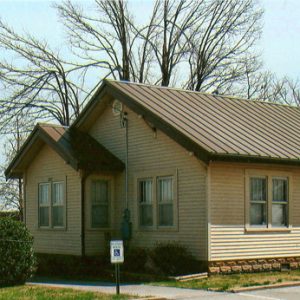calsfoundation@cals.org
Tontitown Historical Museum
The Tontitown Historical Museum, located on Highway 412 in Tontitown (Washington County), preserves the Italian-American history of the local community. Tontitown was settled by Italians who had originally come to southeastern Arkansas in the 1890s to be tenant farmers but broke away and moved to northwestern Arkansas. The museum opened on August 10, 1986, and was dedicated on September 21, 1986. The museum receives some funding from the City of Tontitown and also operates from donations.
The Tontitown Historical Museum is housed in the former Bastianelli home, built in 1910. Bastianelli family members were original settlers of Tontitown in 1898. Three sisters from the family were very active in Tontitown life. Rose Bastianelli was a teacher, Zelinda Bastianelli was postmistress, and Mary Bastianelli worked as a housekeeper and personal secretary for both Father Pietro Bandini, who was the priest and leader for the community from before its founding to his death in 1917, and his nephew, Father Titus Bandini, who served another group of Italian immigrants in Gilroy, California.
Over their long lives, the Bastianelli sisters collected and preserved Tontitown artifacts and memorabilia. When the last sister, Zelinda, died in 1985, at the age of 102, she left the family home to St. Joseph Catholic Church. Through the efforts and generosity of many in the community, the city purchased the Bastianelli home to house the collection, and the Tontitown Historical Museum has grown and developed ever since.
The museum displays artifacts from many parts of Tontitown’s history. The entry to the museum displays a history of the immigration from Italy, as well as the departure from the Sunnyside Plantation, where the community initially settled. Exhibits show how Tontitown’s Italians have made a living over the years, mainly through agriculture, including apple, grape, and wine production. An entire room is dedicated to artifacts from St. Joseph’s Catholic Church and from various priests, representing the central role the Roman Catholic Church played in Tontitown life for generations. The museum also has a large collection of items that belonged to—or are believed to have belonged to—Father Pietro Bandini, including a secretary desk that houses the original town seal and checks from the Bank of Tontitown.
The museum shares the story of Tontitown by publishing books and hosting events. A pictorial history, “So Big, This Little Place”: The Founding of Tontitown, Arkansas, 1898–1917, and collection of oral histories titled Memories I Can’t Let Go Of: Life Stories from Tontitown, Arkansas were published in collaboration with Susan Young and the Shiloh Museum of Ozark History. Two annual events are hosted by the museum. Tontitown Heritage Day is held in May and usually follows the year’s theme set by the Department of Arkansas Heritage. The event is held at Harry Sbanotto Park, where the museum is located. Tours are offered, and in 2014, a bocce tournament was added. The Polenta Smear is held annually in November. Community members are encouraged to bring old photographs to be copied for the museum and are often asked to help identify individuals in pictures that have already been collected. The crowd is served polenta, a northern Italian dish of corn meal porridge, baked and cut into squares, with umido, a red sauce with chicken.
The museum is governed by a board of directors and operates with an all-volunteer staff, supported by the employees of the City of Tontitown. The museum welcomes visitors most weekends and some weekdays.
For additional information:
Tontitown Historical Museum. http://www.tontitown.com/index.php/tontitown/museum (accessed December 7, 2020).
Rebecca Howard
University of Arkansas, Fayetteville
 Historic Preservation
Historic Preservation Tontitown Historical Museum
Tontitown Historical Museum 




Comments
No comments on this entry yet.